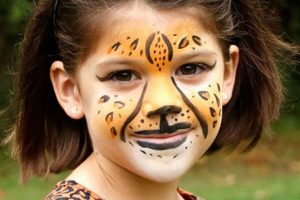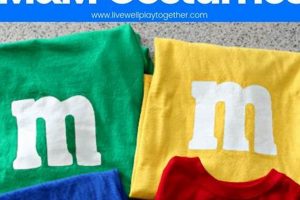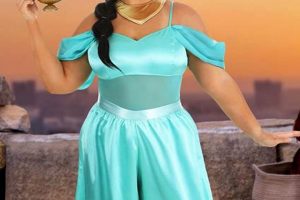Creating a homemade feline fatale outfit involves the construction of a costume inspired by the DC Comics character Catwoman, utilizing materials and techniques accessible to individuals with varying levels of crafting experience. This undertaking typically includes the assembly of a catsuit or similar garment, along with characteristic accessories such as a mask, gloves, and boots. For example, an individual might repurpose a black jumpsuit, adding handmade ears and a painted mask to emulate the character’s appearance.
The appeal of constructing such an outfit lies in its affordability and potential for personalization. Rather than purchasing a pre-made costume, individuals can tailor the design to their specific preferences and body type. Furthermore, the process fosters creativity and resourcefulness, often leading to unique and innovative interpretations of the iconic character’s look. Historically, fan-made costumes have provided avenues for self-expression and community engagement within fandoms, reflecting evolving cultural interpretations of established fictional figures.
The subsequent sections will provide detailed guidance on selecting appropriate materials, constructing key components, and achieving a polished final product. Consideration will be given to various approaches, ranging from simple adaptations of existing clothing items to more involved sewing and crafting projects.
DIY Catwoman Costume
The following tips offer practical advice for individuals seeking to create a cost-effective and visually appealing Catwoman costume, emphasizing construction techniques and material selection.
Tip 1: Pattern Adaptation is Crucial: Begin with a commercially available catsuit pattern or a close-fitting garment pattern. Modify the pattern to ensure a smooth, streamlined silhouette, eliminating unnecessary seams or embellishments that deviate from the character’s classic aesthetic.
Tip 2: Material Selection Impacts Appearance: Opt for a fabric with a slight sheen, such as stretch vinyl or faux leather, to emulate the character’s sleek appearance. Matte fabrics may appear dull and lack the desired visual impact. Test fabric stretch before committing to large-scale cutting.
Tip 3: Mask Construction Requires Precision: Utilize a rigid material, such as craft foam or thermoplastic, to create the mask’s base. Ensure symmetrical shaping and a secure, comfortable fit. Consider incorporating wire reinforcements to maintain the mask’s form and prevent deformation.
Tip 4: Ear Attachment Demands Durability: Securely attach the ears to the mask using industrial-strength adhesive or rivets. Reinforce the attachment points with fabric scraps or additional layers of the mask material to prevent detachment during wear.
Tip 5: Glove Detailing Enhances Realism: Enhance standard gloves with details such as claw embellishments, stitching patterns, or textured panels to further emulate the character’s design. Consider using a durable adhesive to attach claws and ensure they are securely fastened.
Tip 6: Consider Boot Modification Carefully: Modify existing boots, rather than attempting to construct them entirely from scratch. Add cuffs or overlays to alter the boot’s appearance, ensuring a secure and comfortable fit. Test all modifications before final assembly.
Tip 7: Ensure Proper Fit and Movement: Prioritize comfort and range of motion. Perform a test fit of all components before final assembly to identify any areas that restrict movement or cause discomfort. Make necessary adjustments to ensure a comfortable and functional costume.
By adhering to these guidelines, individuals can achieve a professional-looking and durable Catwoman costume that effectively captures the essence of the character.
The next section will address accessorizing the diy catwoman costume and adding the finishing touches.
1. Material Selection
The success of a DIY Catwoman costume hinges significantly on material selection. The chosen materials dictate the costume’s visual impact, durability, and wearer comfort. A poorly chosen fabric, for instance, can undermine the entire endeavor, resulting in a costume that lacks the intended sleekness and sophistication. Conversely, a well-considered material palette can elevate a simple design to a professional-looking piece. The selection process isn’t merely aesthetic; it’s intrinsically linked to the structural integrity and longevity of the costume. Real-life examples of this are readily apparent. A costume constructed from inexpensive, non-stretch fabric may tear easily and restrict movement, diminishing the overall effect. In contrast, using a high-quality, stretch vinyl or faux leather can create a form-fitting and visually striking representation of the character.
Furthermore, material selection extends beyond the primary fabric used for the catsuit. The construction of accessories, such as the mask and gloves, also demands careful consideration. The mask might require a rigid thermoplastic for shaping and durability, while the gloves may benefit from a flexible, textured material to simulate claws. The choice of adhesives, paints, and other embellishments plays a critical role in achieving a cohesive and professional finish. The practical application of this understanding lies in the ability to anticipate challenges during the construction process. For example, selecting a fabric that is difficult to sew or that requires specialized cleaning can significantly increase the time and effort required to complete the costume. Therefore, research and experimentation are vital before committing to a particular material.
In conclusion, material selection forms a foundational element in the construction of a DIY Catwoman costume. The material dictates the costume’s appearance, durability, and wearer comfort, while influencing construction complexity. Challenges related to material properties can be overcome through careful planning and experimentation. Ultimately, the success of the costume depends on a comprehensive understanding of the interplay between design, material, and construction technique.
2. Pattern Adaptation
Pattern adaptation is a critical stage in creating a bespoke Catwoman costume. Adapting existing patterns allows for customization, ensuring a precise fit and accurate design, distinguishing a homemade garment from a generic, store-bought version.
- Base Pattern Selection
The foundation of pattern adaptation involves selecting a base pattern, often a catsuit or bodysuit pattern, that closely resembles the desired silhouette. The choice of pattern is influenced by the sewer’s skill level and the complexity of modifications planned. Example: Using a leotard pattern as a base for a simpler costume and a tailored catsuit pattern for a more complex design. Inaccurate base pattern selection will require extensi
ve alterations, increasing the risk of errors. - Fit Customization
One of the primary benefits of pattern adaptation lies in tailoring the fit to the wearer’s body measurements. Generic patterns often require adjustments to accommodate individual variations in height, torso length, and bust size. Example: Lengthening the torso of a pattern to accommodate a taller individual, or adding darts to contour the bust area. Failure to adjust the fit can result in a costume that is uncomfortable or unflattering.
- Design Modification
Pattern adaptation allows for incorporation of specific design elements characteristic of the Catwoman costume, such as paneling, seam lines, and embellishments. This involves altering the pattern pieces to create the desired visual effect. Example: Adding strategically placed seams to create a more sculpted appearance or incorporating textured panels for visual interest. Poorly executed design modifications can detract from the overall aesthetic appeal.
- Fabric Considerations
Pattern adaptation should account for the properties of the chosen fabric, such as stretch and drape. Adjustments may be necessary to accommodate the fabric’s behavior and ensure a proper fit. Example: Reducing seam allowances when using a highly elastic fabric or adding ease for a less flexible material. Neglecting to account for fabric properties can result in a costume that is too tight or too loose.
By carefully adapting a base pattern to individual measurements, design preferences, and fabric characteristics, a DIY Catwoman costume can achieve a professional-looking finish and a comfortable fit. Pattern alteration skill is essential for converting basic patterns into representations of the iconic character’s attire.
3. Mask Construction
In the context of a DIY Catwoman costume, mask construction represents a pivotal element, directly influencing the costume’s overall visual impact and recognizability. A poorly constructed mask can undermine an otherwise well-executed costume, while a skillfully crafted mask can elevate the entire ensemble. The mask serves as the focal point of the character’s persona, encapsulating mystery and feline grace. Consider, for example, a homemade costume where the catsuit is meticulously tailored, but the mask is ill-fitting and asymmetrical; the overall effect diminishes significantly. Conversely, a simpler catsuit paired with a detailed and well-formed mask can successfully capture the essence of the character. This underscores the mask’s disproportionate importance within the complete attire. The construction process demands attention to detail, including precise shaping, secure attachment of ears, and comfortable integration with the wearer’s face. These elements are not merely aesthetic considerations; they impact the wearer’s visibility, comfort, and ability to convey the character’s demeanor.
Practical applications of successful mask construction extend beyond mere aesthetics. A well-designed mask should allow for sufficient ventilation to prevent overheating and fogging, particularly during extended wear at events. The choice of materials also impacts durability and longevity. Opting for a rigid thermoplastic, for instance, provides greater structural integrity than using simple craft foam, resisting deformation and maintaining the mask’s shape over time. Furthermore, the method of securing the mask to the face is critical. Elastic straps, while common, can be uncomfortable and prone to slipping. Alternative methods, such as integrating the mask with a wig cap or using adjustable Velcro straps, can provide a more secure and comfortable fit. The practical understanding of these aspects leads to greater wearer confidence and improved performance during events or performances.
In summary, mask construction holds a position of significant importance within the broader context of a self-made Catwoman costume. Proper planning, material selection, and construction techniques translate to a visually compelling, durable, and comfortable mask, essential for completing the overall look and successfully embodying the character. Challenges related to design and comfort can be mitigated through careful consideration of the factors discussed, ultimately contributing to a more fulfilling and authentic costume experience. The mask serves as the key element tying the entire costume together.
4. Ear Attachment
The secure and aesthetically pleasing attachment of ears to the mask represents a critical step in achieving a convincing homemade Catwoman costume. This detail significantly contributes to the character’s recognizability and overall visual impact.
- Structural Integrity
The method of ear attachment directly impacts the durability and longevity of the mask. A flimsy or poorly executed attachment can lead to the ears detaching during wear, compromising the costume’s appearance. Examples of strong attachment methods include industrial-strength adhesives, rivets, or stitching directly to the mask base. Conversely, relying on weaker adhesives like craft glue often results in premature failure. The structural integrity of the ear attachment directly relates to the costume’s ability to withstand use and handling.
- Aesthetic Harmony
The placement and angle of the ears contribute significantly to the mask’s aesthetic appeal. Symmetrical placement and a natural-looking angle enhance the feline appearance. Real-world examples include studying reference images of professionally made Catwoman masks to understand the ideal ear positioning. Improper ear placement can create a distorted or unnatural look, detracting from the overall costume quality. This element emphasizes the importance of visual accuracy in replicating the character’s iconic design.
- Material Compatibility
Selecting attachment methods that are compatible with both the mask material and the ear material is crucial. For example, if the mask is made of a rigid thermoplastic and the ears are made of craft foam, using an adhesive that bonds well with both materials is essential. Rivets may be a better choice for more robust materials. Incompatible materials can result in weak bonds and eventual separation. This consideration highlights the need for understanding material properties when constructing the costume.
- Wearer Comfort
The attachment method should not compromise the wearer’s comfort. Bulky or protruding attachments can create pressure points and discomfort, particularly during extended wear. Smooth, flush attachments are preferable to minimize irritation. Examples of comfort-focused attachment methods include carefully sanding down any sharp edges and using soft padding to cushion the ears against the forehead. Prioritizing comfort is essential for ensuring the wearer can confidently and comfortably embody the character.
Effective ear attachment, therefore, necessitates a balanced approach, combining structural integrity, aesthetic harmony, material compatibility, and wearer comfort. Careful consideration of these facets is paramount for achieving a high-quality, durable, and visually appealing self-made Catwoman costume. The connection between these elements ensures a cohesive and believable portrayal of the iconic character.
5. Glove Detailing
Glove detailing occupies a significant position in the overall aesthetic of a self-constructed Catwoman costume. The gloves, often extending to the mid-arm or elbow, serve as a prominent visual element, and their level of detailing directly influences the costume’s perceived quality and authenticity. Inadequate detailing on the gloves can detract from the overall impact of the costume, even if other components are well-executed. Conversely, thoughtfully applied detailing can elevate a simpler catsuit, creating a more convincing representation of the character. For instance, the addition of subtle claw-like embellishments, strategically placed stitching patterns, or the incorporation of textured panels can contribute significantly to a more refined and realistic look.
The practical application of this understanding lies in the selection of appropriate detailing techniques and materials. Simple techniques, such as carefully trimming and shaping the glove cuffs to create a stylized silhouette, can be highly effective. More advanced techniques might involve adding individual claw components crafted from durable materials like thermoplastic or resin, securely affixed to the glove surface. Consideration must also be given to the comfort and functionality of the gloves; overly elaborate detailing can restrict movement or create pressure points, detracting from the wearer’s experience. Examples of successful detailing implementation include custom-sewn gloves with integrated faux leather panels, or the application of subtly textured paint to create the illusion of scale-like patterns. Conversely, the use of flimsy, ill-fitting gloves with poorly attached, oversized claws represents a common pitfall to be avoided.
In conclusion, glove detailing is a crucial component in the creation of a high-quality Catwoman costume. Thoughtful attention to detail, appropriate material selection, and the skillful application of detailing techniques contribute significantly to the costume’s visual appeal and authenticity. While seemingly a minor aspect, the execution of glove detailing can dramatically impact the overall impression of the costume, reinforcing the importance of considering every element in the pursuit of a convincing and recognizable portrayal of the iconic character. Proper execution elevates the costume from simple to stunning.
6. Boot Modification
Boot modification constitutes a significant element in the creation of a visually accurate and credible homemade Catwoman costume. The footwear, often thigh-high or knee-high boots, forms a defining feature of the character’s silhouette. Consequently, the degree to which existing boots are modified, or new boots are constructed, directly impacts the overall effectiveness of the costume. Simplistic boot choices or the complete absence of appropriately styled footwear can noticeably detract from the intended aesthetic. Conversely, thoughtful and well-executed boot alterations enhance the costume’s authenticity. As an example, standard black boots can be transformed into character-appropriate footwear through the addition of custom-made cuffs, sculpted detailing, or carefully applied paint to mimic textures and paneling seen in various Catwoman iterations. The cause-and-effect relationship is direct: deliberate boot modification yields a more convincing costume.
Practical applications of boot modification involve several techniques, ranging from basic to advanced. Attaching pre-fabricated or handmade cuffs to existing boots represents a relatively straightforward approach. These cuffs, constructed from materials like faux leather or stretch vinyl, can replicate the distinctive shape and detailing often associated with Catwoman’s boots. More involved modifications may include altering the boot’s shape through the addition of structural elements, such as internal supports or external overlays. Painting and weathering techniques can also be employed to create a worn or textured appearance. Furthermore, practical considerations extend to comfort and functionality; modifications should not impede the wearer’s ability to walk or move freely. Ensuring a secure fit and avoiding any alterations that might compromise the boot’s structural integrity are paramount.
In summary, boot modification plays a crucial role in completing a successful self-made Catwoman costume. The effort invested in modifying or selecting appropriate footwear directly correlates with the visual impact and authenticity of the final product. Challenges associated with boot modification, such as maintaining comfort and ensuring structural integrity, can be overcome through careful planning and execution. The end result serves as a testament to the costume’s overall quality, linking the individual component back to the broader theme of creating a credible and recognizable representation of the iconic character. The boots tie the costume together from head to toe.
7. Comfort/Mobility
In the realm of self-fashioned Catwoman costumes, the relationship between comfort and mobility occupies a position of considerable importance. The aesthetic appeal of a costume is inextricably linked to its functionality, and a design that sacrifices comfort and mobility for visual accuracy often undermines its purpose. The direct consequence of prioritizing visual fidelity over practicality is a costume that restricts movement, impedes performance, and ultimately detracts from the wearer’s ability to embody the character convincingly. As a case in point, a catsuit constructed from non-stretch materials may perfectly replicate the character’s sleek silhouette, but the wearer may experience significant limitations in range of motion, preventing them from executing dynamic poses or movements characteristic of Catwoman. Prioritizing visual accuracy without accounting for practicality yields an unsatisfactory outcome.
The practical application of this understanding lies in the selection of appropriate materials and construction techniques. Employing stretch fabrics, such as spandex or lycra blends, allows for a form-fitting silhouette without compromising movement. Incorporating gussets in strategic areas, such as the underarms and crotch, further enhances mobility. The design must consider the anticipated activities of the wearer, whether it be posing for photographs, engaging in light combat choreography, or simply navigating crowded environments. Neglecting to address these factors can lead to discomfort, overheating, and even potential injury. For example, a mask that restricts airflow or impairs vision can pose a safety hazard. Therefore, ensuring adequate ventilation and visibility is paramount. Examples of successful integration of comfort and mobility include costumes that incorporate breathable fabrics, adjustable closures, and ergonomic designs, enabling the wearer to move with agility and confidence.
In summary, the relationship between comfort and mobility is fundamental to the success of any DIY Catwoman costume. The interplay between these elements dictates the wearer’s ability to embody the character effectively and confidently. Challenges related to balancing visual accuracy with practicality can be overcome through careful material selection, strategic design modifications, and a thorough understanding of the wearer’s anticipated activities. Ultimately, a costume that prioritizes
both comfort and mobility will not only look impressive but will also enhance the wearer’s experience, allowing them to fully embrace the role. The integration of comfort and mobility is as crucial as the visual elements.
Frequently Asked Questions
This section addresses common inquiries and concerns regarding the creation of a self-made Catwoman costume. The information provided aims to clarify potential challenges and offer practical guidance for achieving a successful result.
Question 1: What is the recommended material for a DIY Catwoman costume catsuit?
Stretch vinyl or faux leather is typically recommended due to its sleek appearance and form-fitting properties. Matte fabrics may appear dull and lack the desired visual impact.
Question 2: How can symmetrical ear placement be ensured on a Catwoman mask?
Precise measurements and the use of templates are crucial. Marking the intended attachment points with a ruler and ensuring equal distances from the mask’s center line minimizes asymmetry.
Question 3: What adhesives are suitable for attaching embellishments to Catwoman gloves?
Industrial-strength adhesives designed for bonding fabric and plastics are recommended. Testing the adhesive on a small, inconspicuous area before full application is advisable.
Question 4: How can mobility be maintained in a form-fitting Catwoman catsuit?
Selecting stretch fabrics and incorporating gussets in areas that require a greater range of motion, such as the underarms and crotch, can significantly improve mobility.
Question 5: What are the best methods for securing a Catwoman mask to the face?
Elastic straps, integrated wig caps, or adjustable Velcro straps can be used. The chosen method should prioritize a secure and comfortable fit without impeding visibility or causing discomfort.
Question 6: How can standard boots be effectively modified to resemble Catwoman’s signature footwear?
Adding custom-made cuffs, sculpted detailing, or carefully applied paint can transform standard boots into character-appropriate footwear. Consideration should be given to maintaining comfort and ensuring a secure fit.
The points covered offer insights on materials, precision, and comfort necessary to be successful at a homemade Catwoman costume. Addressing the issues can improve the result.
The subsequent section will delve into additional considerations for enhancing the DIY Catwoman costume, focusing on advanced techniques and personalization options.
DIY Catwoman Costume
The preceding discussion has illuminated the multifaceted nature of constructing a “diy catwoman costume”. The key points emphasized involve careful material selection, precise pattern adaptation, meticulous mask construction, secure ear attachment, thoughtful glove detailing, effective boot modification, and the crucial balance between comfort and mobility. Each element contributes significantly to the overall aesthetic and functional integrity of the final product.
The endeavor to create a “diy catwoman costume” is a complex undertaking, demanding both technical skill and artistic vision. The success of such a project hinges not only on the replication of visual details but also on a thorough understanding of costume construction principles. It is incumbent upon the costume artisan to approach this task with diligence, precision, and a commitment to quality craftsmanship in order to achieve a truly compelling and enduring result. The pursuit of excellence in this domain ensures that the final creation stands as a testament to both the character and the skills of the maker.







